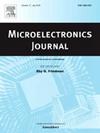DFF中时钟set诱导SEU的频率依赖性
IF 1.9
3区 工程技术
Q3 ENGINEERING, ELECTRICAL & ELECTRONIC
引用次数: 0
摘要
虽然存储单元的静态扰动和存储单元间组合逻辑中的单事件瞬变(SET)扰动对时钟信号的频率依赖性已经得到了广泛的研究,但对于SET扰动对时钟信号的影响如何随着时钟频率的增加而变化还没有研究。利用动态双拷贝敏感性分析与评估方法(DDC-SAEM),研究了由时钟逆变器或时钟缓冲器中发生的单事件干扰(seu)引起的d型触发器(DFF)的频率依赖性。对时钟缓冲器中的PMOS和NMOS晶体管分别在65 nm和28 nm制程节点上进行了80000和130000次随机电模拟。统计结果表明,随着时钟频率的增加,时钟set引起的SEU数最初几乎与频率无关。随着频率的增加,SEU数量急剧增加,最终相关曲线收敛。65纳米技术的饱和点约为78%,28纳米技术的饱和点为88%。这意味着与DFF中直接产生的扰动在时钟频率的增加和减少方面保持相对恒定不同,时钟信号上的set引起的SEU的概率与时钟频率密切相关。当时钟频率超过一定值时,时钟set引起的SEU将变得非常显著。在设计高性能、高可靠性的集成电路时,需要特别注意。本文章由计算机程序翻译,如有差异,请以英文原文为准。
Frequency dependence of Clock-SET-induced SEU in DFF
Though frequency dependence of static upset in a storage cell and upset caused by single-event transient (SET) in combinational logic between storage cells have been investigated extensively, there is no research on how the upset due to SET on the clock signal changes as the clock frequency increases. Using the Dynamic Dual-Copy Susceptibility Analysis and Evaluation Methodology (DDC-SAEM), the frequency dependence of single event upsets (SEUs) in D-type flip-flop (DFF) caused by SETs occurred in clock inverters or clock buffers is investigated. 80000 and 130000 random electrical simulations were made on the PMOS and NMOS transistors in the clock buffer at the 65 nm and 28 nm process nodes, respectively. Statistical results indicate that, as the clock frequency increases, clock-SET-induced SEU numbers are almost independent on the frequency at first. Then the SEU numbers increases sharply with increasing frequency, and finally the correlation curves converge. The saturation point is around 78% in the 65 nm technology and 88% in the 28 nm technology, respectively. It means that unlike the upset directly generated in the DFF, which remains relatively constant in terms of clock frequency increase and decrease, the probability of SEU induced by SETs on the clock signal is closely related to the clock frequency. When the clock frequency exceeds a certain value, the clock-SET-induced SEU will become very significant. When designing high-performance and high-reliability integrated circuits, it needs to be particularly paid attention to.
求助全文
通过发布文献求助,成功后即可免费获取论文全文。
去求助
来源期刊

Microelectronics Journal
工程技术-工程:电子与电气
CiteScore
4.00
自引率
27.30%
发文量
222
审稿时长
43 days
期刊介绍:
Published since 1969, the Microelectronics Journal is an international forum for the dissemination of research and applications of microelectronic systems, circuits, and emerging technologies. Papers published in the Microelectronics Journal have undergone peer review to ensure originality, relevance, and timeliness. The journal thus provides a worldwide, regular, and comprehensive update on microelectronic circuits and systems.
The Microelectronics Journal invites papers describing significant research and applications in all of the areas listed below. Comprehensive review/survey papers covering recent developments will also be considered. The Microelectronics Journal covers circuits and systems. This topic includes but is not limited to: Analog, digital, mixed, and RF circuits and related design methodologies; Logic, architectural, and system level synthesis; Testing, design for testability, built-in self-test; Area, power, and thermal analysis and design; Mixed-domain simulation and design; Embedded systems; Non-von Neumann computing and related technologies and circuits; Design and test of high complexity systems integration; SoC, NoC, SIP, and NIP design and test; 3-D integration design and analysis; Emerging device technologies and circuits, such as FinFETs, SETs, spintronics, SFQ, MTJ, etc.
Application aspects such as signal and image processing including circuits for cryptography, sensors, and actuators including sensor networks, reliability and quality issues, and economic models are also welcome.
 求助内容:
求助内容: 应助结果提醒方式:
应助结果提醒方式:


